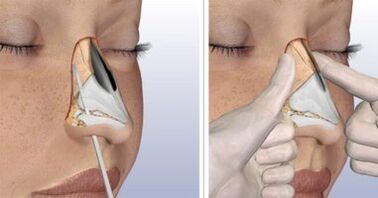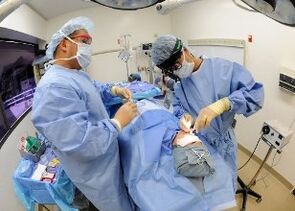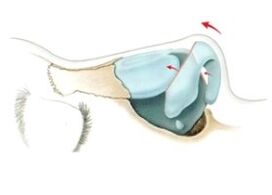
Rhinoplasty or rhinoplasty is a branch of plastic surgery that specializes in correcting congenital or acquired deformities, as well as restoring individual segments of the nose or the entire organ.
Rhinoplasty operations can increase or decrease the size of the nose, change its shape and eliminate breathing problems. The aesthetic goal of rhinoplasty is to achieve harmony of facial features by correcting defects in the nose. As a rule, this type of operation is performed upon reaching the age of 18-21, since until this time there is a physiological growth of bone and cartilage tissues.
The task of rhinoplasty is to restore the correct forms and functions of the nose, which were impaired as a result of injuries or during the period of embryogenesis. Rhinoplasty is a range of different operations, which will be discussed in more detail below.
Israeli clinics provide excellent results, the medical care provided meets the expectations of patients.
During rhinoplasty in Israel, open or closed access can be used, depending on the purpose of the operation. With closed rhinoplasty, an incision is made in the cavity, the skin is exfoliated from the framework (cartilage and nasal bones). This method is used to change the shape, remove cartilage and excess bones, etc. If a large volume of surgery is planned, an open rhinoplasty of the nose is prescribed when incisions are made in the columella (vertical skin fold separating the nostrils).
Nose correction is divided into primary and secondary. Revision or secondary plastic surgery is carried out in order to eliminate the defects that remain after the primary operation.
In recent years, fillers have been actively used in rhinoplasty if it is necessary to correct minor imperfections of the nose: change the shape of the wings, restore symmetry, round the tip of the nose, etc.
Rhinoplasty surgery in Israel: planning and implementation

In Israeli clinics, the patient is first consulted by a plastic surgeon, he examines the shape of the nose, the condition of the tissues, and diagnoses nasal breathing disorders. In order to obtain the best cosmetic results, photographs and computer modeling of the nose are taken. The patient is also consulted by an ENT doctor. If there are pronounced defects, when nasal breathing is disturbed, nose rhinoplasty is performed together with an otolaryngologist and a plastic surgeon.
As a rule, during the operation, general anesthesia is used in combination with local infiltration anesthesia. The duration of rhinoplasty depends on the complexity and takes 1-2 or more hours. In order to give the nose a more aesthetically advantageous size and shape, the surgeon changes the bone and cartilage frame. Properly performed rhinoplasty in Israel and the absence of complications - and postoperative scars will not actually be visible.
Recovery period after nose correction
After surgery, tampons are installed in the nasal passages, they are removed after 2-3 days. In order to fix the new form, a special plaster or colloid sticker is applied for five to seven days (if the plastic touched the cartilaginous part of the nose) or for twelve to fourteen days (if the bone part).
As a result of swelling, nasal breathing can be difficult in the first weeks. Bruises and swelling go away within ten to fourteen days. It is not recommended to wear glasses for one and a half months after the nose correction. The full course of recovery takes six to eight months, it is then that the final results of the operation will be visible. Smoking and taking certain medications can slow recovery.
Rhinoplasty in Israel: removal of the hump of the nose

This operation is multi-stage. In the process of its implementation, the osteocartilaginous protrusion of the back of the nose is eliminated. The hunchback can be caused by trauma or hereditary factors.
If the hump of the nose is small, local anesthesia may be used, if large - general. The duration of the surgical intervention is 1-2 hours.
First, the surgeon dissects and removes the skin from the bone-cartilaginous base of the nose - the stage of skeletonization. After that, the cartilage is cut and the cartilaginous segment of the septum is removed gradually, starting from the smallest volume. Then the bone component of the hump of the nose is excised.
After the hump is removed, the skeleton takes the form of a truncated pyramid. An osteotomy is performed to bring the nasal bones together and remove the wide platform. The surgeon dissects the bone tissue of the lateral slopes and brings them closer to the upper segments. To eliminate irregularities, he uses contour plastic using the patient's own cartilage or various implants. At the end of the nose correction, cotton swabs are placed in the nasal passages, and a plaster bandage is applied to fix the new position of the tissues. The plaster is removed after eight to ten days.
For several weeks after the removal of the hump of the nose, hemorrhages and swelling in the nose area persist. As the edema subsides, nasal breathing is restored. The final result of the operation can be assessed in six months, when the tissues are completely restored.
Septoplasty of the nose in Israel

This is an operation to correct the nasal septum while preserving the bone and cartilage framework. This type of plastic allows you to achieve an aesthetic result and eliminate difficulty breathing.
The nasal septum is a thin vertical bone and cartilage plate, which is easily deformed, leading to impaired respiratory function and deterioration of the aesthetic appearance. The reasons may be injuries, rickets suffered in childhood, hereditary predisposition.
Contraindications are:
- severe pathologies of internal organs;
- oncology;
- infectious diseases;
- problems with blood clotting;
- diabetes.
Indications for septoplasty of the nose:
- allergic pathologies (itching, runny nose, etc. );
- difficulty in nasal breathing and its absence;
- chronic and acute diseases of the paranasal sinuses (frontitis, ethmoiditis, sinusitis);
- vasomotor rhinitis and frequent nosebleeds;
- snoring due to impaired nasal breathing, etc.
In case of exacerbation, septoplasty is performed two weeks after its elimination. The indication for an operation in Israel is determined by an otolaryngologist based on anamnesis and diagnosis (rhinoscopy). Before the operation, laboratory tests, ECG, X-ray of the lungs are performed.
As painkillers, infiltration anesthesia can be used (with the help of injections it is injected into the nasal septum), local application anesthesia (turundas impregnated with an anesthetic are injected into the nasal passages), as well as general anesthesia.
With septoplasty in Israel, the surgeon makes an incision inside the nose or endonasally, as a result, there is no visible postoperative scar. On both sides of the nasal septum, it exfoliates the mucous membrane, highlights and removes the curved parts of the bone structures and the quadrangular cartilage of the septum. Upon completion of the nose correction, sutures are applied and tamponade is performed with finger or gauze swabs. A sling-like bandage is applied to the nose.
Also, septoplasty in Israel is performed using endoscopic access. An endoscope with fiber optics is inserted into the nasal cavity, which allows you to see hard-to-reach departments on the monitor and perform the operation as correctly as possible. This type of septoplasty of the nose provides minimal damage to cartilage and tissues, reducing the recovery period.
In addition, laser septoplasty is used in Israeli clinics, thanks to which the development of bleeding and edema can be prevented, since the laser "seals" the vessels by cutting tissues. Moreover, it provides an antiseptic effect.
The duration of septoplasty is determined by the degree of curvature of the septum, the operation can last from thirty minutes to one and a half hours.
This type of rhinoplasty is quite easily tolerated. The patient is in the hospital until the nasal swabs are removed. Ten to fourteen days is enough to restore working capacity, full rehabilitation takes about a month.
Rhinoplasty in Israel: convergence of the bones of the nose
Osteotomy in Israel (reposition of bones, convergence of bones) can be an independent operation that corrects the shape of the nose, or one of the steps to remove the hump of the nose. Thanks to this type of plastic surgery, the surgeon achieves the ideal proportions of the nose to the proportions of the face, reducing the lateral bones of the bridge of the nose.
In the process of osteotomy, it brings together the walls of the bone pyramid, after which the cartilages attached to the bones move. The skin, as a rule, without much difficulty adapts to the changed contours of the back of the nose.
Of the total time of rhinoplasty, osteotomy takes a few minutes. Upon completion of the correction, the nose is sealed with a surgical plaster and fixed with a bandage to maintain its shape and protect it from damage.
Within 2 weeks, hematomas and edema disappear. New contours are finally formed within one year.
Rhinoplasty in Israel: nose tip support

Support for the tip of the nose is provided by a stable, strong and correct arrangement of cartilage. Normally, they are slightly above or below the line that runs along the back of the nose.
Insufficient support is caused by undesirable consequences of rhinoplasty (when adequate support is not provided) or age-related processes of tissue ptosis (ligaments that support cartilage weaken).
In order to create support, the entire outer nose is shaped proportionately and correctly. The nasolabial angle (formed by the upper lip and columella) is considered to be the norm - 90-120 °.
During rhinoplasty in Israel, the tip of the nose can be raised by seven to eight millimeters above the back profile line. The skin of the tip has difficulty adjusting to changes because it is less elastic and thicker.
In order to restore support, transplanted cartilage grafts - "props" can be used. The surgeon places such cartilage between the lateral cartilages and fixes it, then cuts it to the desired size.
Also, the tip graft can be placed perpendicular to the support, on the cartilage. This option is used when the cartilage of the tip of the nose is damaged and is not used for self-support. The ideal source for a graft is cartilage from the nasal septum.
If it is not possible to obtain a graft from the tip, cartilage may be taken from the pinna. However, it is considered not strong enough to hold pressure and form. Therefore, often the ear cartilage is connected to a strong and thin bony nasal septum. Part of the bone is glued onto a cartilage graft.
Rhinoplasty in Israel: nose shortening
Nose shortening is a plastic surgery that reduces the length of the external nose. Most often, the length of the cartilage of the septum is reduced, in more rare cases, the side wall of the nose, which is formed by large alar, triangular cartilages and bones.
Various methods are used to estimate the length of the nose. The most common method is to measure the distance from the tip of the nose to the bridge of the nose. Another method involves determining the magnitude of the nasolabial angle.
As we age, the ligaments that hold the cartilage weaken, the tip of the nose drops and visually increases its length. For this reason, in adulthood, patients shorten the length of the nose less than in young ones.
Types of surgeries in Israel that shorten the nose
With a long nose, as a rule, the cartilaginous and bony sections of the nose, triangular and alar cartilages in the transverse and longitudinal directions, and the cartilaginous part of the septum are usually evenly elongated. As a result, either operations are performed that shorten the lateral cartilaginous wall of the nose, or resections of the distal sections of the septal cartilage.
In the second option, a partial resection is performed using infiltration anesthesia. The surgeon performs 2 transfection parallel incisions, through which he resects the cartilaginous septa from the mucosa and excise skin strips in the area of the columella. Then the incisions are sutured with catgut threads. As a result, the nose is shortened and the nasolabial angle is increased.
Another way is to increase the nasolabial angle by placing silicone or cartilage liners in front of the maxillary spine.
Rhinoplasty in Israel: nose tip correction

This type of rhinoplasty in Israel can be performed in several ways. The operation is performed on the terminal section of the external nose: its shape is improved by removing deforming or excessive parts of the cartilage tissue, and a new position is fixed.
Nose tip correction is a complex aspect of rhinoplasty, the task of which is to restore harmonious anatomical properties without disturbing the supporting structures of the organ.
Due to the variety of options for correcting the tip of the nose, an individual rhinoplasty plan in Israel is developed, which takes into account the strength and shape of cartilage, skin thickness, width and length of the nose, nasolabial angle, anatomy of the vault angles, back contour and the wishes of the patient himself.
To narrow the tip of the nose, the surgeon cuts out segments of the alar cartilage and partially removes fatty tissue. A variant can be used, during which the domes are dissected and sutures are applied, narrowing or connecting them to each other.
Rhinoplasty in Israel: reposition of a fractured nose
This operation to correct the nose involves restoring the displaced bone fragments to the normal position. The optimal time for this plasty is the first hours after the fracture, until soft tissue edema develops, or the next 3-7 days, when the edematous state decreases. 10 days after the injury, a callus is formed, so reposition can no longer be carried out.
Forty percent of all cases of facial injuries are fractures of the bones of the nose, caused by sports injuries, street and domestic fights, traffic accidents, falls. Such a fracture can be closed and open, without displacement and with displacement of bone fragments. The symptoms of a fracture include deformity of the external nose, swelling, pain, mucous discharge, hemorrhage, wounds, abrasions, nosebleeds due to rupture of the mucous membrane. Moreover, the sense of smell and nasal breathing are disturbed.
For diagnostic purposes in Israel, the patient is interviewed, they can perform an external and endonasal examination, endoscopic examination, radiography of the bones of the nose.
A fairly common consequence of a bone fracture is the curvature of the nasal septum, which is accompanied by recurring sinusitis, rhinitis, and impaired nasal breathing. Correction of the curvature can only be done surgically.
Another complication may be a hematoma of the nasal septum under the mucous membrane, it narrows the lumen of the nasal passages and makes breathing difficult. Perhaps its suppuration and subsequent destruction of cartilage. Therefore, high-quality and prompt medical care for fractures of the nasal bones is extremely important.
Cold (ice or a cold compress) can be used as a first step to reduce swelling and pain and stop bleeding.
In the Israeli clinic, plastic surgeons perform reposition of bone fractures. During the first 6-7 days, the reposition is carried out with the use of local anesthesia manually in order for the bones to grow together correctly in the future. A tight tamponade of the cavities with turundas is performed in order to press and support the nasal skeleton. A bandage is applied outside.
Self-reduction is strictly prohibited due to additional trauma. After the swelling subsides, the aesthetic and respiratory function of the nose is evaluated. Bone fractures can lead to deformation of the osteochondral part of the nose and its lateral displacement, narrowing of the nasal passages, curvature of the septum, etc.
If the bones of the nose do not grow together correctly, patients are often forced to subsequently turn to rhinoplasty. To restore impaired breathing, a deviated septum is corrected - rhinoseptoplasty is performed.
Rhinoplasty in Israel: correction of the wings of the nose

This type of operation is performed to change the width, thickness and symmetry in the presence of pronounced aesthetic flaws and deformation. Various methods are used depending on the violations. For repair, tissues surrounding the defect are mobilized or a cartilage or skin graft is moved.
Correction of the wings of the nose can be an independent operation or the final stage of rhinoplasty in Israel.
Defects of the wings of the nose are acquired and congenital in nature, they are complete or partial. The reasons are the consequences of nose correction or removal of tumors, trauma, burns and diseases.
Most operations to correct the wings of the nose are performed using local infiltration anesthesia. If there are extensive defects, intravenous anesthesia is used.
Sometimes tip plasty is used to correct the wings of the nose. In this case, this operation completes the rhinoplasty. If aesthetic defects are expressed, the correction is carried out during the main phase of the operation.
When it is necessary to reduce the distance between the wings of the nose, incisions are made at the base of the wings from the vestibule and along the contour. Cutaneous and mucocutaneous segments are excised, hemostasis is performed, and sutures are applied. The scars are placed in the folds of the wings of the nose and natural nasolabial folds, making them virtually invisible.
If it is necessary to restore the support of the wings of the nose (in case of retraction or injury), areas of neighboring tissues are moved, a skin flap or own cartilage is transplanted from the auricle or nasal septum, specially modeled.
The rehabilitation period can last five days, in the case of cartilage reconstruction - seven or more.
Rhinoplasty in Israel: complete nose correction
This type of rhinoplasty in Israel involves complex rhinoplasty, which is performed in the structural segments of the external nose and in the thickness of the tissues of the organ. They can reduce the length of the nose, change its shape, remove the hump, narrow the width of the back, adjust the tip. Together with plasty, they restore the respiratory function and the normal architectonics of the cavity.
Most often, this operation is performed after injuries.
In most cases, the correction is performed through a closed (endonasal) approach, excluding external skin incisions. Superficial manipulations can be performed using local anesthesia and intravenous sedation, operations on deep structures require general anesthesia. This nose correction is possible in the age group - 18-40 years.
Rhinoplasty in Israel can be combined with the following plastic surgeries: blepharoplasty, facial skin tightening, chin and lip surgery, liposuction, breast lift, etc.
Before the operation, the anatomical structure of the nose is carefully analyzed and its future shape is modeled on a computer. In case of violation of nasal breathing, the nasal cavity is examined, radiography or tomography is done.
Modern rhinoplasty in Israel uses sparing techniques that provide excellent results and minimize the likelihood of complications.




















